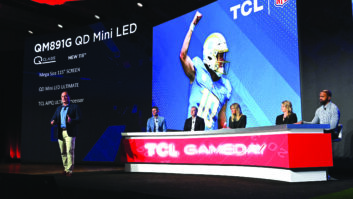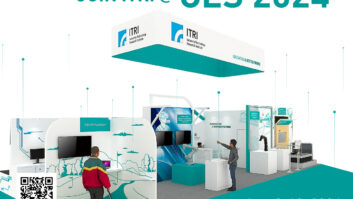LG Electronics (LGE) and Samsung used International CES as a campaign stop for their competing mobile digital television systems — one of which could be selected for a standard to deliver a new class of portable digital television devices in 2009.
During the show both companies discussed or demonstrated their respective systems, and revealed that the Open Mobile Video Coalition (OMVC), an association of nearly 800 television broadcasters across the country, would begin separate field trials of the formats on the road to selection of a national mobile DTV standard. Those trials, which will begin later this year, will include consumer feedback.
At LGE’s CES press conference, Woo Paik, LGE president and chief technology officer, said that since the development of digital broadcasting, broadcasters have sought a system with the capability of delivering programming to mobile viewers.
LG, which holds the patents to the 8-VSB modulation scheme used in the current ATSC television broadcast system for stationary reception, developed along with Harris Communications their Mobile Pedestrian Handheld (MPH) technology to provide broadcast quality video receivable by devices moving at speeds of up to 140 miles per hour.
The system will also be capable of working with the current ATSC DTV broadcast standard, LG said, and can use existing infrastructure including transmission towers.
Paik said LG has developed chips that will enable consumer devices to receive MPH signals.
MPH will deliver one or more mobile TV channels using a small portion of the ATSC 19.4Mbps ATSC signal. Existing TV towers can transmit the mobile TV signal along with the existing ATSC channel using an MPH exciter at the head end.
Consumers will be able to receive the MPH signal from a variety of devices including mobile phones, portable media players, laptop PCs and portable navigation devices with MPH chips inside.
LG said MPH has several advantages over competing mobile TV systems including DVBH, Paik said. First, MPH will allow local broadcasters, rather than service providers, to send signals to handheld devices, like cellphones, offering “a compelling mix of local and national content,” without the need of using several towers or additional spectrum.
Paik said prototype MPH chips and prototype devices have been developed and broadcast services could be ready to begin in 2009. Trials will begin later this year.
“The mobile TV market in this country can grow into several billions of dollars in the next few years,” said Paik.
Samsung showed its Advanced-Vestigial Sideband (A-VSB) mobile DTV technology developed by Samsung, Rohde & Schwarz and Nokia.
That system builds on the existing ATSC transmission standard to enhance digital DTV receivers’ ability to receive the main transport stream in mobile environments. The system enables broadcasters to include multiple streams with additional error correction and time diversity encoding for enhanced reception.
The A-VSB technology allows for synchronization of multiple transmission towers, which could be used to improve coverage with higher uniform signal strength throughout a service area, including areas that normally have problems receiving DTV signals such as areas shielded with hills or tall buildings.
The A-VSB system is composed of three elements including: a Supplementary Reference Signal (SRS), a Scalable Turbo Stream (STS), and support for Single Frequency Networks (SFN).
The OMVC will conduct separate nationwide trials of the systems this year. The A-VSB system trial will be tested by a consortium of mobile DTV backers including Samsung, Rohde & Schwarz, Nokia Siemens Networks, MobiTV and SES Americom.
Both trial will use SES Americom’s IP PRIME facility in Vernon Valley, N.J. Several test markets will be selected by the OMVC. A sample of consumers will be chosen to receive and test mobile video content that will be broadcast to mobile and portable receivers.










